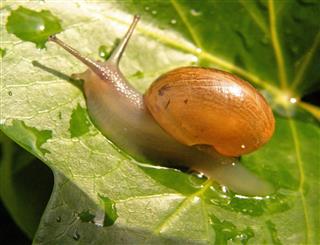
Water snails can be a very wise addition to your aquarium if you know how to care for them. Here are some facts and information about the water snails.
For all I know, you might be viewing water snails (like all other snails), as a gray mass of slime. But do you know that there are different types of snails that live in water? And generalizing them into a gray mass is not really fair. If you study these snails in deep and know more about some water snails facts, then you just might be forced to change your opinion about them. Let’s try to find some more facts about these snails that dwell in water in the sections that are to follow.
Freshwater Snails
Breathe using Gills
- Common River Nerite (Theodoxus fluviatilis)
- Common Mud Snail (Viviparus viviparus)
- Common Bithynia (Bithynia tentaculata)
Breathe using Lungs
- Great Pond Snail (Lymnaea stagnalis)
- River Limpet (Ancylus fluviatilis)
- Acute Bladder Snail (Physella acuta Draparnaud, 1805)
- Ram’s Horn Snail (Planorbarius corneus)
As Pets
Snails can make for an interesting choice of aquarium pets. This is mainly owing to the fact that they act as scavengers and feed on the decaying and decomposing plants and animals in the tank, thereby keeping it clean. They help to maintain a high water quality in the tank as well as keep a check on the growing algae. Another advantage of having these snails as pets is that they will get into all the small nooks and corners and clean up all the algae there as well. Thus making them really advantageous (for the lack of a better term) pets to have.
Care
If the prospect of introducing snails to your aquarium interests you, then you will need to know more in connection with how to care for water snails. Caring for snails in water requires you to follow some caution. You cannot simply introduce them in the tank. Here is what you will need to keep in mind before keeping them as pets.
All Alone?
Be extremely careful when you introduce the snails to your tank. There is every chance that if there are other aquarium fish in your tank, they will end up feasting on the snails. Varied fish like the eels, large catfish, puffers, and loaches will feed on the slimy water snail. Make sure that you know the kind of snails and fish that can dwell together.
Tank Size
The snails grow to a size of 1 – 4 inches, so if you’re planning on keeping a lot of them, make sure that the tank is big enough for each of them. Also, they end up producing a lot of waste, so constant cleaning becomes necessary. In such a scenario, if the tank is too small, it will end up making the tank environment very toxic. Clean the tank every 20 days by doing a 50% water change.
Temperature and pH Level
The temperature of the tank should be maintained at 65 – 85 degrees F. Other than that, the lighting condition in the tank needs to be maintained at a low light level. The pH level should be about 6.8 – 8.3. Similarly, proper care has to be taken as far as the water hardness is concerned. Different types of snails will require a different range of water hardness. The Ampullariidae family requires a range of 12 – 19 while the other types of water dwelling snails require a range of 8 – 11 for their survival.
Food
If the snails are introduced to a tank which has fish and plants in it, then there is usually no need to feed them anything extra. Be careful when you introduce them to your tank because a large number of them can end up feasting on your plants. But what if there are no plants in the tank? Then the question of what do snails eat comes in. It is a good idea to feed them shrimp pellets, algae wafers, or spirulina. Lettuce, cucumber slices, zucchini, and other green vegetables are favorites among snails. They also need plenty of fiber to help them digest the large amounts of algae that they eat. To supplement this need, a piece of wood has to be introduced in the tank.
It is also necessary to provide them with an extra source of calcium, which you can do by introducing a cuttlebone in the tank. Some people also add calcium supplements in the tank in small doses. Always measure the amount that you sprinkle in to prevent an overdose. Calcium is necessary for these snails because it keeps their shells strong. If the shells weaken, they develop holes in them as well as thin out. Which is never a good sign for the water snails and can lead to their death.
So that’s all there is to know about the water snails. When you buy some from the pet store, make sure to ask for any special instructions or care tactics, as these might be different for different snails.







